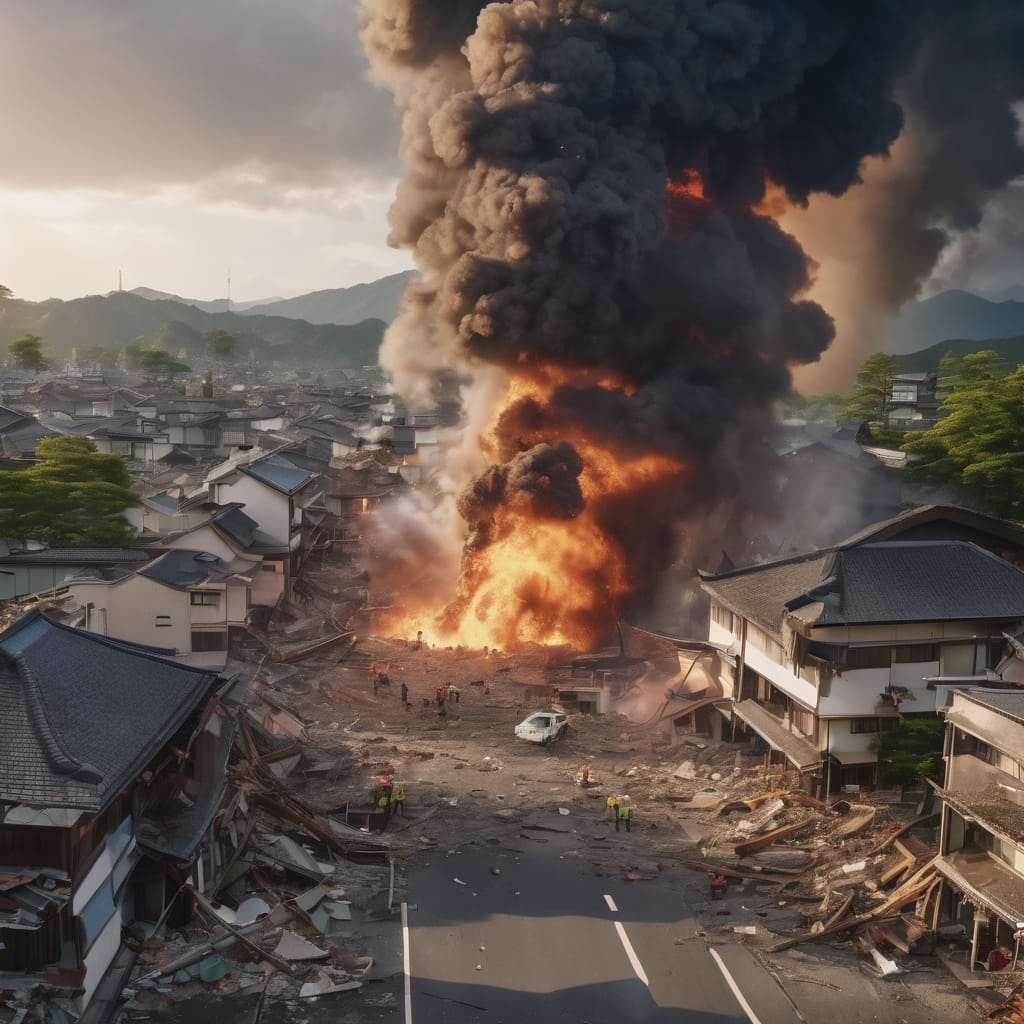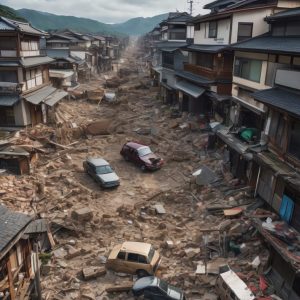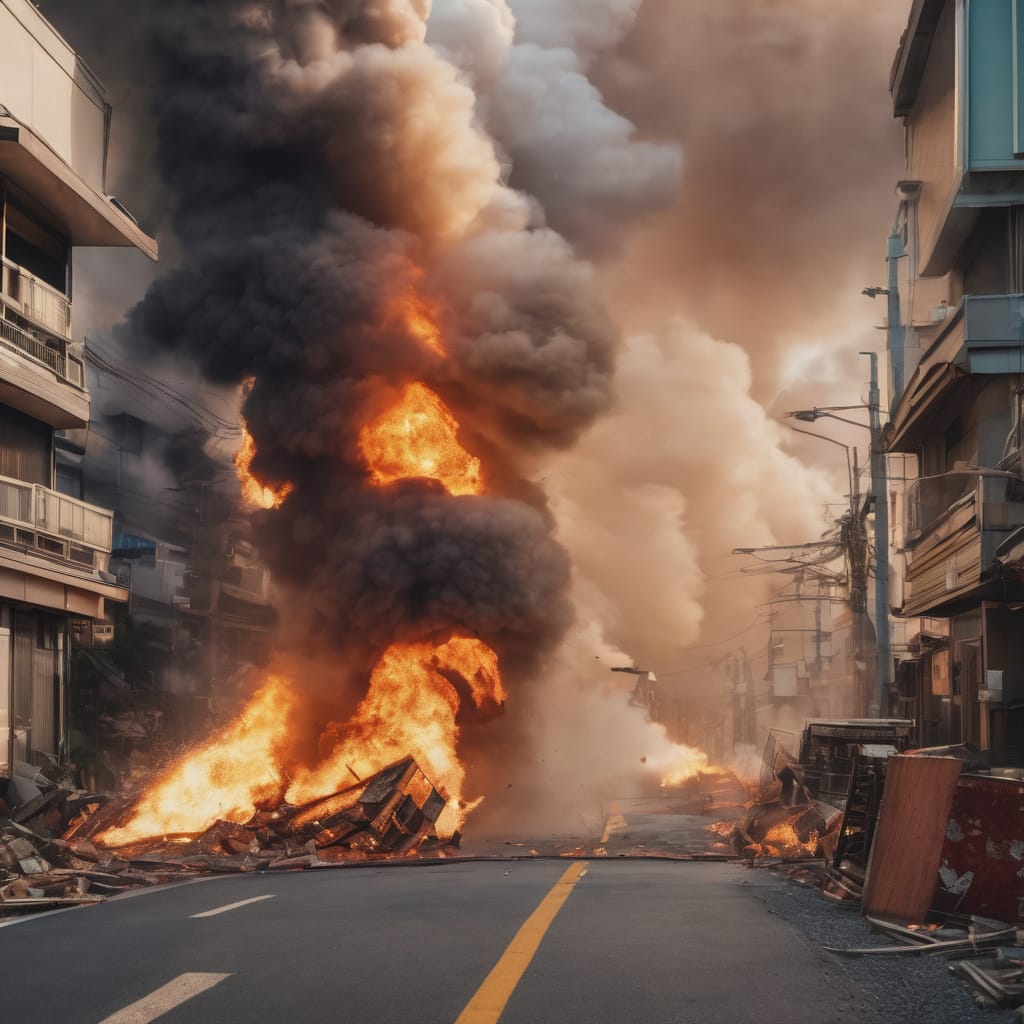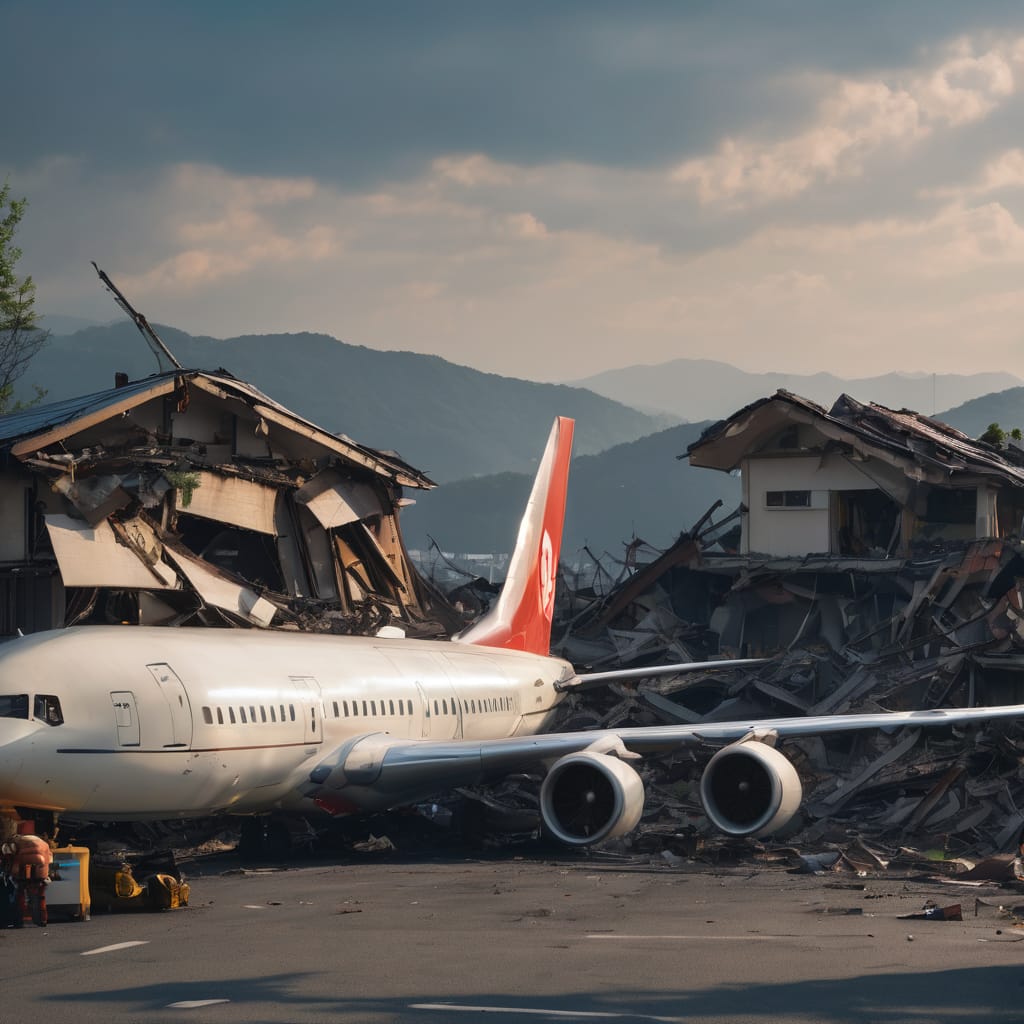Japan Earthquake: Assessing Damage, Rescue Operations Underway
On Monday, Japan faced a significant challenge as a powerful earthquake with a preliminary magnitude of 7.6 struck its west coast, resulting in at least a dozen casualties, destruction of buildings and major roads, and power outages affecting numerous homes in freezing temperatures. The quake, which occurred in the afternoon, led to tsunami waves around 1 meter high hitting Japan’s western seaboard. However, there was no tsunami threat for the western coast of North America.

Emergency Response:
In response to the disaster, thousands of army personnel, firefighters, and police officers have been dispatched to the worst-hit area in the relatively remote Noto peninsula in Ishikawa prefecture. Unfortunately, rescue efforts are being hindered by badly damaged and blocked roads, and an airport in the area had to close due to runway cracks. Many rail services, ferries, and flights into the region have also been suspended.
Prime Minister Fumio Kishida emphasized the urgency of the search and rescue operations during an emergency disaster meeting, stating that reaching the northern tip of the Noto peninsula is challenging due to wrecked roads. Helicopter surveys have revealed numerous fires and widespread damage to buildings and infrastructure.
Casualties and Damage:
Local media reports confirm more than a dozen deaths, primarily in the hard-hit town of Wajima near the quake’s epicenter. A massive blaze broke out in Wajima, adding to the challenges faced by rescue teams. The national police agency has reported six confirmed deaths, and the fire and disaster management agency noted 19 people in a state of cardiac arrest.
Seismic Activity:
Since the initial quake, more than 140 tremors have been detected by the Japan Meteorological Agency. Authorities warn that more strong shocks could occur in the coming days, emphasizing the ongoing seismic activity in the region.
Nuclear Industry Impact:
Given Japan’s sensitive history with nuclear disasters, concerns arose about the impact on nuclear plants. Fortunately, the Nuclear Regulation Authority reported no irregularities at nuclear plants along the Sea of Japan. This includes the five active reactors at Kansai Electric Power’s Ohi and Takahama plants in Fukui Prefecture. Hokuriku Electric’s Shika plant, closest to the epicenter, had already halted its two reactors for regular inspections before the quake and reported no impact.
Corporate Impact:
Beyond the immediate impact on lives and infrastructure, the earthquake has affected businesses. Chip materials maker Kokusai Electric is investigating damage at its factory in Toyama and has delayed the planned resumption of operations on Thursday.
In conclusion, Japan faces a multifaceted challenge following the recent earthquake. The focus remains on rescue operations, addressing casualties, and assessing the broader impact on infrastructure and industries, particularly in the context of Japan‘s complex relationship with nuclear energy. Authorities continue to monitor the situation closely, with the recognition that ongoing seismic activity may pose further challenges in the days ahead.
Understanding Japan’s Earthquake Challenge: Causes and Preventions
Introduction:
Japan, a country nestled in the Pacific Ring of Fire, is no stranger to earthquakes. The recent seismic event on its west coast serves as a stark reminder of the geological challenges this nation faces. In this blog post, we delve into the causes of earthquakes in Japan and explore the preventative measures in place to mitigate the impact of these natural disasters.
Causes of Earthquakes in Japan:
Japan’s unique geological position makes it susceptible to earthquakes. The country sits at the convergence of four major tectonic plates—the Pacific Plate, Philippine Sea Plate, Eurasian Plate, and North American Plate. The Pacific Plate subducts beneath the North American Plate, leading to intense seismic activity.
The recent earthquake off the Noto Peninsula resulted from the release of accumulated stress along a fault line. As tectonic plates shift and grind against each other, energy builds up, eventually causing the Earth’s crust to rupture and release this energy in the form of an earthquake.
Preventative Measures:
While earthquakes are inevitable in Japan, the nation has invested heavily in advanced technologies and infrastructure to minimize their impact. Here are some key preventative measures in place:
Building Codes and Engineering Standards:
- Japan has some of the strictest building codes globally, designed to ensure structures can withstand seismic forces. Modern buildings incorporate flexible materials and base isolation systems to absorb and dissipate energy during an earthquake, reducing structural damage.
Early Warning Systems:
- Japan’s advanced earthquake early warning systems provide crucial seconds to minutes of advance notice. These systems use a network of seismometers to detect initial seismic waves, enabling automated alerts to be sent out through various communication channels. This allows people to take cover and emergency services to prepare.
Public Education and Preparedness:
- Education plays a pivotal role in earthquake preparedness. The Japanese government conducts regular drills and awareness campaigns to ensure the public knows how to react during seismic events. This includes evacuation procedures, designated safe zones, and the importance of having emergency kits readily available.
Infrastructure Resilience:
- Critical infrastructure, such as bridges, highways, and airports, is designed to withstand earthquakes. Ongoing evaluations and retrofitting of existing infrastructure contribute to overall resilience, ensuring that vital transportation links remain functional during and after a seismic event.
Tsunami Warning Systems:
- Given Japan’s coastal geography, tsunamis are a significant concern following earthquakes. The country has a comprehensive tsunami warning system that alerts coastal communities, giving residents time to move to higher ground and escape potential waves.
Conclusion:
While earthquakes remain an unavoidable part of life in Japan, the country’s commitment to innovation, preparedness, and education significantly minimizes the impact of these natural disasters. The recent earthquake serves as a testament to the importance of continued research, investment, and global collaboration in creating resilient societies capable of withstanding the unpredictable forces of nature. As Japan looks toward recovery, the world stands in solidarity, acknowledging the nation’s ongoing efforts to navigate the complex interplay between geology and human resilience.
FAQ :
Q1: What happened in Japan on Monday regarding the earthquake?
A1: On Monday, Japan experienced a powerful earthquake with a preliminary magnitude of 7.6 striking its west coast. This resulted in at least a dozen casualties, destruction of buildings, major roads, power outages, and tsunami waves along the western seaboard.
Q2: What is the current status of emergency response efforts?
A2: Thousands of army personnel, firefighters, and police officers have been dispatched to the worst-hit area in the Noto peninsula in Ishikawa prefecture. However, rescue efforts are being hindered by badly damaged and blocked roads, and an airport in the area had to close. Many rail services, ferries, and flights into the region have been suspended.
Q3: What challenges are rescue teams facing in the affected areas?
A3: The rescue teams are facing challenges due to badly damaged and blocked roads. The airport in the area had to close, and transportation services, including rail, ferries, and flights, have been suspended.
Q4: What is the current casualty count and damage assessment?
A4: Local media reports confirm more than a dozen deaths, primarily in the hard-hit town of Wajima near the quake’s epicenter. There is widespread damage to buildings and infrastructure, and a massive blaze has broken out in Wajima, adding to the challenges faced by rescue teams.
Q5: How is the seismic activity evolving post the initial earthquake?
A5: Since the initial quake, more than 140 tremors have been detected by the Japan Meteorological Agency. Authorities warn that more strong shocks could occur in the coming days, emphasizing the ongoing seismic activity in the region.
Q6: What is the impact on the nuclear industry in Japan?
A6: Fortunately, there are no irregularities reported at nuclear plants along the Sea of Japan. This includes the active reactors at Kansai Electric Power’s Ohi and Takahama plants in Fukui Prefecture. The Hokuriku Electric’s Shika plant, closest to the epicenter, had already halted its two reactors for regular inspections before the quake and reported no impact.
Q7: How has the earthquake affected businesses in the region?
A7: The earthquake has impacted businesses, and chip materials maker Kokusai Electric is investigating damage at its factory in Toyama. Operations at the factory have been delayed.
FAQ for “Understanding Japan’s Earthquake Challenge: Causes and Preventions”
Q1: Why is Japan prone to earthquakes?
A1: Japan is located in the Pacific Ring of Fire and sits at the convergence of four major tectonic plates—the Pacific Plate, Philippine Sea Plate, Eurasian Plate, and North American Plate. The intense seismic activity results from the subduction of the Pacific Plate beneath the North American Plate.
Q2: What preventative measures are in place in Japan to mitigate the impact of earthquakes?
A2: Japan has implemented strict building codes, advanced early warning systems, public education and preparedness initiatives, resilient infrastructure designs, and comprehensive tsunami warning systems.
Q3: How do building codes contribute to earthquake resilience in Japan?
A3: Japan has some of the strictest building codes globally, ensuring structures can withstand seismic forces. Modern buildings incorporate flexible materials and base isolation systems to absorb and dissipate energy during earthquakes.
Q4: What role do early warning systems play in earthquake preparedness?
A4: Japan’s advanced earthquake early warning systems provide crucial seconds to minutes of advance notice by using a network of seismometers to detect initial seismic waves. This allows people to take cover, and emergency services can prepare.
Q5: How does public education contribute to earthquake preparedness?
A5: The Japanese government conducts regular drills and awareness campaigns to educate the public on how to react during seismic events. This includes evacuation procedures, designated safe zones, and the importance of having emergency kits readily available.
Q6: What measures are taken to ensure the resilience of critical infrastructure during earthquakes?
A6: Critical infrastructure, such as bridges, highways, and airports, is designed to withstand earthquakes. Ongoing evaluations and retrofitting of existing infrastructure contribute to overall resilience, ensuring vital transportation links remain functional during and after seismic events.
Q7: How does Japan’s tsunami warning system work?
A7: Given Japan’s coastal geography, the country has a comprehensive tsunami warning system that alerts coastal communities, allowing residents time to move to higher ground and escape potential waves.
Q8: What does the recent earthquake highlight about Japan’s approach to resilience and preparedness?
A8: The recent earthquake serves as a testament to Japan’s commitment to innovation, preparedness, and education, significantly minimizing the impact of natural disasters. It underscores the importance of continued research, investment, and global collaboration in creating resilient societies capable of withstanding the unpredictable
